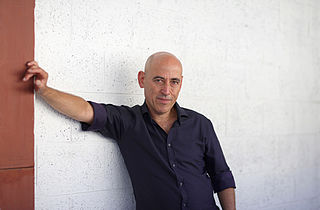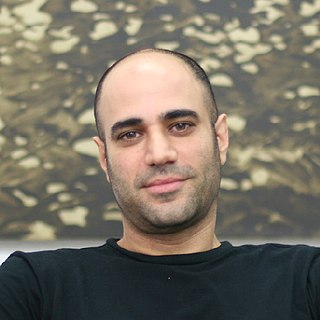
Yocheved (Juki) Weinfeld is an artist, museum educator and developer of interactive exhibitions for children. She studied at the Tel Aviv University and the State Art Teacher's College (Israel); at the Hebrew University of Jerusalem and at the Michaelis School of Art at the University of Cape Town in South Africa).
Michael Gross was an Israeli painter, sculptor and conceptual artist.

Avraham Ofek was a multidisciplinary Israeli artist.

Buky Schwartz was an Israeli sculptor and video artist.

Pinchas Cohen Gan is a Moroccan painter and mixed-media artist. He was awarded the Sandberg Prize (1979), the Culture and Sport Ministry's prize for his life's work (2005), and the Israel Prize in Art (2008).

Mordechai (Motti) Mizrachi is an Israeli multimedia artist who creates politically engaged conceptual works that combine sculpture, video, photography, public art and performance. Dough, Via Dolorosa (1973) and Healing (1980) marked the emergence of avant-garde Israeli performance and video art. Since the 1980s, he has created numerous site specific public sculptures.

Avni Institute of Art and Design is an Israeli art school located in Tel Aviv.

Michael Gitlin is a contemporary sculptor.

Siona Shimshi was an Israeli painter, sculptor, ceramist, and textile designer.

Nahum Tevet is one of the leading Israeli artists whose work was among the earliest to respond to the minimalist canon by introducing into his installations everyday domestic objects, metaphors and images like in: Corner (1973-4) and Arrangements of Six Units.

Visual arts in Israel or Israeli art refers to visual art or plastic art created by Israeli artists or Jewish painters in the Yishuv. Visual art in Israel encompasses a wide spectrum of techniques, styles and themes reflecting a dialogue with Jewish art throughout the ages and attempts to formulate a national identity.
Mirit Cohen was a Russian-born Israeli sculptor and painter. Cohen resided in New York City from 1975. In 1990, she committed suicide.

The Negev Museum of Art is an art museum in the Old City of Be'er Sheva, Israel. The building is the former Governor's Mansion, built in 1906 by the Ottomans as part of government edifices that include the Seraya and the local mosque.

Israeli sculpture designates sculpture produced in the Land of Israel from 1906, the year the "Bezalel School of Arts and Crafts" was established. The process of crystallization of Israeli sculpture was influenced at every stage by international sculpture. In the early period of Israeli sculpture, most of its important sculptors were immigrants to the Land of Israel, and their art was a synthesis of the influence of European sculpture with the way in which the national artistic identity developed in the Land of Israel and later in the State of Israel.

Michael Sgan-Cohen was an Israeli artist, art historian, curator and critic. His oeuvre touches different realms of the Israeli experience and the Hebrew language, displaying a strong connection to the Jewish Scriptures. His works were nurtured by his extensive knowledge of Art history, philosophy, Biblical Texts, Jewish thought and Mysticism, which in turn illuminated all these pursuits. His engagement with Judaism and the Bible as a secular scholar and his vast knowledge of modern and contemporary art contributed to the development of a distinctive approach which combined Jewish and Israeli symbols and images to create a multilayered and contemporary artistic language.
Joav BarEl, (1933–1977) was an Israeli artist, critic, and lecturer.
Michael Druks was an Israeli-born British artist.

Ruth Zarfati-Sternschuss was an Israeli painter, sculptor and illustrator. She was a member of the Ofakim Hadashim art movement.
Moshe Roas is an Israeli artist, who works in sculpture, drawing, printmaking and installation art. He has exhibited in galleries and museums in Netherlands, (Germany), Poland, United States, South Korea and Israel. These include the Tel Aviv Museum of Art, the Eretz Israel Museum, the Jerusalem Print Workshop and the Tel Aviv Artists' House.

Gilad Efrat is a leading contemporary Israeli painter and a professor at the Shenkar College of Engineering and Design, Israel.



















